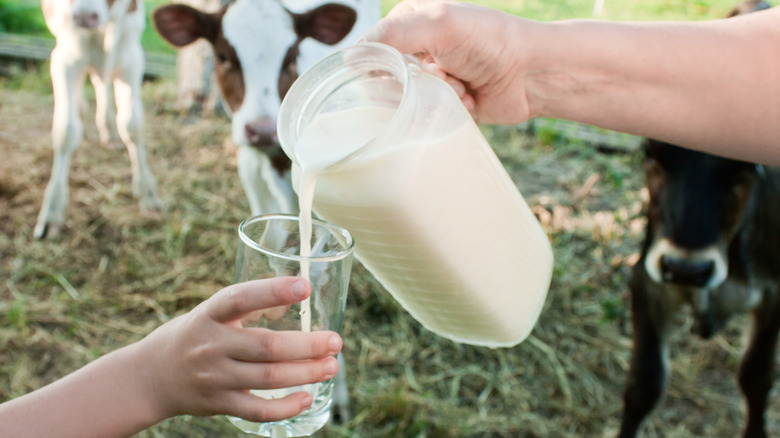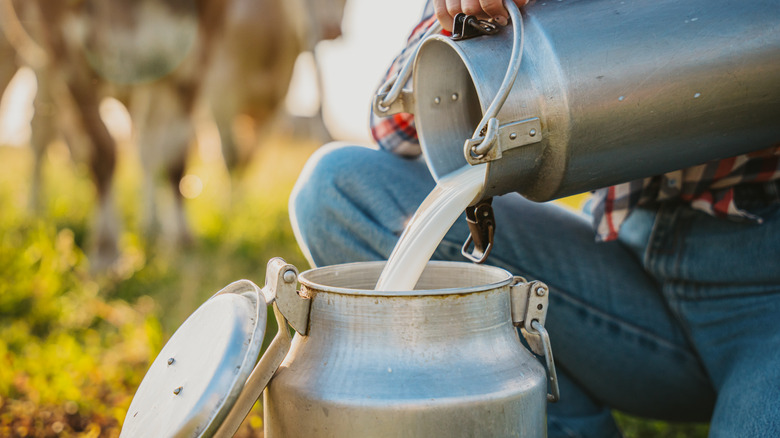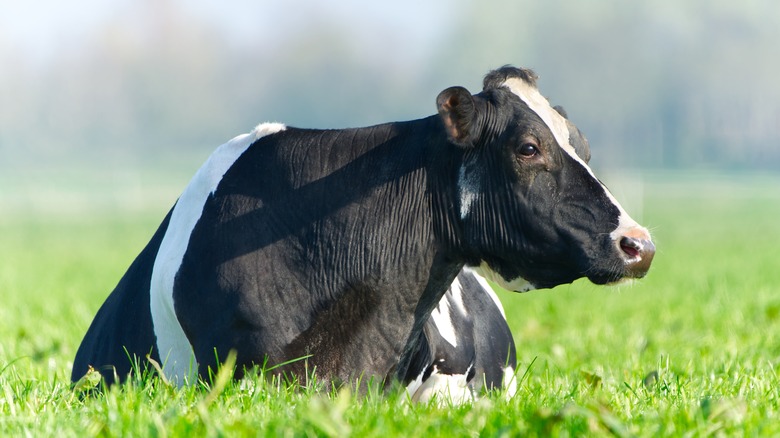What's So Special About Raw Milk (And Is It Safe)?
You might have seen raw milk in the news lately and wondered what exactly it is. In point of fact, it's pretty simple: Raw milk is just milk that hasn't undergone a heating process known as pasteurization, which is designed to kill off harmful bacteria. Buying raw milk is legal in a lot of U.S. states, but is it safe to drink raw milk? According to most health experts, the answer is no.
These experts note that raw milk is a health risk for a variety of reasons. Much like eating raw liver, raw milk carries with it a serious risk of foodborne illness, resulting in symptoms like diarrhea, vomiting, and abdominal pain, as the FDA makes clear. It can be particularly deadly for children, pregnant women, the immunocompromised, and the elderly. It can also cause outbreaks, such as in 2014, when listeria illness and death were linked to raw milk from a Pennsylvania organic farm.
Advocates at the Raw Milk Institute, however, argue that "carefully produced raw milk has numerous health advantages over pasteurized milk." These advantages are allegedly that raw milk is more nutritious, easier to digest, possesses probiotics, strengthens the immune system, and helps to prevent or treat conditions like asthma and allergies. They also assert that raw milk is easier for those with lactose intolerance to drink.
Raw milk's health benefits are mostly unsupported by science
Many health organizations believe these claims are largely unsupported. According to the FDA, pasteurized milk does not contain fewer nutrients or fatty acids, or less protein, and it has no immune-strengthening effect. They also state it does not contain probiotic organisms, nor does it help cure or treat asthma or allergies, or aid in digestion. Meanwhile, a 2014 study did not show any reduction in lactose intolerance symptoms from raw milk. The FDA isn't alone, as many of their assertions are backed up by the National Institute of Health, and the American Academy of Pediatrics even supports a ban on the sale of raw milk.
There's another potential risk to raw milk, too. Avian flu, or H5N1, is a dangerous illness that has been found in a variety of avian and mammalian organisms, and it's currently thought to be a growing problem for dairy cows. H5N1 is not yet transmissible from person-to-person, but humans have caught it from animals, including a dairy worker in Texas and another in Michigan. The CDC states that high levels of H5N1 have been found in raw milk, but the current risk of human infection from drinking the raw milk of infected cows remains unknown.
Pasteurization eliminates and deactivates contaminants in raw milk
Pasteurization appears to strongly combat many health risks associated with raw milk. The process involves heating a food to a specific temperature for a brief period of time in order to kill off harmful bacteria (in the case of milk, 145 degrees Fahrenheit for half an hour or 161 degrees Fahrenheit for 15 seconds). Nothing is added to the milk during the pasteurization process; it's simply a heat treatment. The available data tells us that when milk is pasteurized, it kills harmful bacteria.
It appears to also deactivate the H5N1 virus. And while a recent FDA survey of retail milk did show remnants of H5N1 in some samples of pasteurized milk, they stated it wasn't at levels that would pose a health risk. The agency noted that "These findings further support our assessment that the milk safety system including pasteurization is effective against this virus and that the commercial milk supply remains safe."
In fact, pasteurization actually became prominent in the United States specifically because of an epidemic. The U.S. and Europe suffered from an early 1900s bovine tuberculosis outbreak that killed 65,000 people over 25 years. Since then, pasteurization has been the prevailing practice in the U.S. dairy industry.


